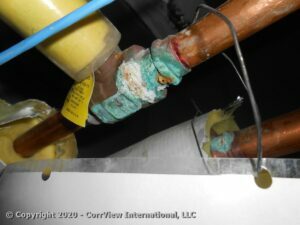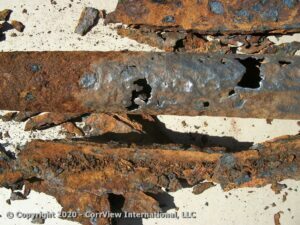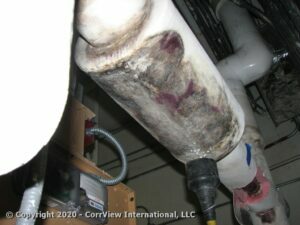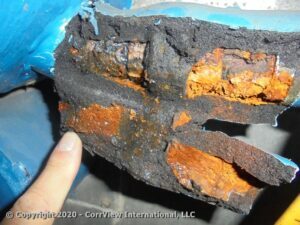Case History: CH-09
Advanced Piping Failure
|
Corrosion Does Not Recognize The Demand For, Nor The Political Correctness Of Going “Green” |
-
Preface
A new 350,000 square foot L.E.E.D certified high tech office building is designed and constructed incorporating the latest “Green” technologies. It is specifically marketed to tenants of the computer industry. A major component of its HVAC design is a popular and well known non-chemical water treatment device which is advertised to work based upon imparting a magnetic residence to the water. As the literature claims, the magnetic resonance of the water in turn prevents corrosion and scaling from occurring to the entire piping system. This “green” non-chemical device benefits the building’s L.E.E.D. status by not using chemicals, and by eliminating cooling water blowdown.
The building has a large central condenser water system serving three individual package air conditioning units on each floor as well as multiple computer room air conditioning units. The building has never had traditional chemical treatment corrosion control, and has only been operated with the non-chemical electronic / magnetic device installed.
After approximately 1 year of 24 / 7 operation, the engineering department finds elevated levels of iron oxide rust in its cooling tower pans and strainers. Opening the refrigeration heads after the 1st year of operation shows unusually high pitting to the water box and tube sheet, further suggesting a corrosion problem. The chief engineer for the building contacts CorrView International, LLC to gain some further insight to the effectiveness of this specific non-chemical device, and expresses his doubts to the manufacturer’s claims of near total corrosion, scale, and microbiological control.
Although rust is unquestionably present within the piping system, they have corrosion coupon test results all showing a low wall loss of under 1 MPY.
A request is made to submit a proposal to ultrasonically inspect their condenser water piping system. Approval is quickly made to the proposal and a date set for the survey. Soon after, the investigation is cancelled by upper level building management. Although the chief engineer suspects problems, the building management team feels that the device is working extremely well as guaranteed by the manufacturer, and that no corrosion problems exist.
-
Investigation
Approximately 6 months later, a real estate interest hires CorrView International, LLC to perform a due diligence piping survey at an out-of-state proposed building acquisition. Although the property is very new and no corrosion problems have been revealed or disclosed by the building owner or during their own due diligence engineering review, our client has no experience with the non-chemical corrosion control system they have encountered during a prior walk through of the building.
Only upon arriving at the property to perform the inspection do we realize that this is the same office building which had contacted CorrView International about their suspected corrosion issue months before. Building personnel are the same, but now in the presence of a potentially new owner and property management team, acknowledge no prior contact with CorrView International. A preliminary discussion with building engineering personnel relates no operating or corrosion problems. All building staff provide very favorable comments regarding the non-chemical device, and state that it has met or exceeded their expectations.
Initial testing of the system shows far lower wall thickness than expected for relatively new 12 in. schedule 40 pipe. With an ASTM starting wall thickness of 0.406 in., initial exploration shows measurements of near 0.355 in., and individual examples of deep pitting to approximately 0.075 in. below factory specifications. Some random high thickness measurements near 0.400 in. show that the pipe was not undersized.
Ultrasonic testing is performed throughout the pump room, cooling tower area, computer rooms, and at all distribution run-out piping to the individual units where we identify similar results in all areas. Rough calculations produce an average corrosion rate of near 30 mils per year (MPY), and areas of deep pitting which exceed 75 MPY.
Smaller 3 in. run-out piping at the units is all threaded schedule 40, and show a current wall thickness below minimum acceptable limits. Photographs are taken at multiple examples of threaded pipe where leaks are present. Two emergency repair clamps at 3 in. distribution lines are found and documented with photographs. Such failures provide unquestionable proof that the 0.111 in. threaded thickness of schedule 40 pipe ( 0.216 in. minus the thread cut of 0.105 in.) has been compromised in under 18 months. This loss of 0.111 in. translates into a corrosion rate of 83 MPY!
The wall thickness information is presented to our client purchasing the property that same day. Although prior to our formal final report, the client decides the damage to the condenser water system would require too many resources to correct, if even possible, and that it would place them at too great a risk given the high tech tenants currently under lease.
The decision is made to back out of the sale, and no reduction in the price of the property is offered to accommodate the findings made by CorrView International, LLC.
-
Conclusion
Packing up our equipment at the end of the day we express to the building personnel thanks and appreciation for their help and cooperation to out testing effort. We vaguely express that we have uncovered certain concerns relating to the condition of the condenser water piping, and ask what their previously stated favorable impression of the non-chemical device is based upon.
One maintenance mechanic states that the non-chemical system is great since they do not have to move heavy drums of chemical to the roof.
© Copyright 2023 – William P. Duncan, CorrView International, LLC




















